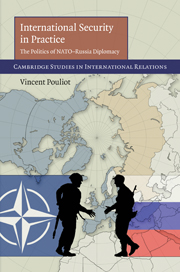7 - Conclusion
Published online by Cambridge University Press: 03 May 2010
Summary
The world of international security works quite differently from the point of view of its practitioners than from that of the distant observer. As this book has shown, interstate pacification is less about people representing one another as part of the same “we,” than it is about joining together in the increasingly commonsense enactment of diplomacy. Practices always rest on an engagement with the world inherited from past interactions and framed by social configurations. By emphasizing practical logics, I certainly do not deny that the theoretical point of view also sheds crucial light on political processes, not least by making sense of practicality in a larger historical and contextual perspective. But this analytical incisiveness requires that social scientists, and more specifically IR scholars, pay equal attention to the logic of practicality in world politics.
In this concluding chapter I want to do three main things. First, I shall wrap up the book's key arguments and highlight in particular how my theory of practice of security communities helps understand the fundamentally hysteretic nature of NATO–Russia diplomacy in the post-Cold War era. Second, I shall briefly return one last time to my case study in order to glean a few policy-relevant insights from my Bourdieu-inspired analytical framework. Third, and finally, I shall address the implications that practice theory raises for IR theory in general. Far from a competing paradigm, practice theory actually overlaps in innovative ways with some essential parts of existing theories.
- Type
- Chapter
- Information
- International Security in PracticeThe Politics of NATO-Russia Diplomacy, pp. 231 - 250Publisher: Cambridge University PressPrint publication year: 2010

